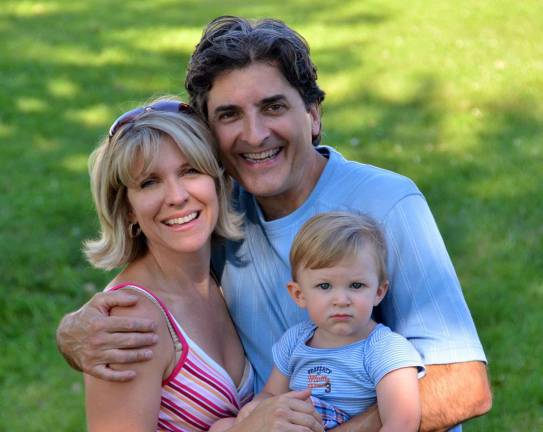Singing for a Cure


WANTAGE — Faith Anderson is a 25-year professional performing artist that was diagnosed with multiple sclerosis in 2010.
“It was six weeks after the birth of my son Darios James,” Anderson said. “I was feeling unusual weakness in my legs that I blamed on the epidural I received during labor, but weeks turned into months and I was still in pain.”
Anderson received a Western Blot Lyme test which came back positive for Lyme disease. A six-week antibiotic regiment followed by three months of intensive therapy provided no relief.
“I was feeling my body slowing down,” Anderson said, “less-inspired to do things that made me happy. I’m normally a firecracker, and found I didn’t have any energy.”
An MRI revealed a small amount of lesions on her brain and spine, and later a neurologist confirmed relapsing-remitting multiple sclerosis in June of 2014 with a lumbar puncture (LP) or ‘spinal tap.’
In MS patients, CSF (cerebrospinal fluid) will have higher amounts of certain proteins called oligoclonal bands with elevated levels of IgG antibodies.
About 2.5 million people worldwide have MS and 400,000 in the U.S. alone. It is not a genetic condition. Rather, it’s caused by an immune-mediated attack targeting components of the myelin sheath, which acts as a form of insulator allowing for neuronal communication.
There are four types of Multiple Sclerosis, each one characterized worse than the last: Relapsing-Remitting MS (RRMS), Secondary-Progressive MS (SPMS), Primary-Progressive MS (PPMS) and Progressive-Relapsing MS (PRMS).
“It took me almost two months to acquire the incredibly expensive medication—Tecfidera—a neurologist prescribed me. After four months on it, I lost half of my hair, suffered skin irritation and endured night sweats where I was soaking my sheets,” Anderson said. “Hardly any medication to treat MS ever actually does the job. So, I got off of it and started digging.”
Anderson said she found some online success stories for those who chose to remedy their symptoms nutritionally, like Dr. Terry Wahls from Iowa who was diagnosed with SPMS. After spending four years in a tilt-recline wheelchair, Wahls began to walk again after changing her diet. In Anderson’s case, dieting did not improve her condition.
In 2008, Dr. Paolo Zamboni from the University of Ferrara in Italy came up with the idea that CCSVI (chronic cerebrospinal venous insufficiency), an abnormality in blood drainage from the brain and spinal cord, may contribute to nervous system damage in MS after his wife was diagnosed in 1999. He proposed treatment for CCSVI in the form of an angioplasty procedure where blocked or narrowed veins are opened to allow for better blood flow.
“In 2014, I had the $15,000 out-of-pocket CCSVI treatment procedure in Ohio. Some people have had success with it. Unfortunately, it wasn’t the answer for me,” Anderson said.
“I continued to decline and my desire to live was waning.”
Anderson came across pain specialist Dr. Roberta F. Shapiro’s video entitled, “A New York Doctor’s Path to Panama” about stem cells, which have been successfully used in slowing MS disease activity and repairing damage to the nervous system.“I got on the phone with Holly Huber from California, who was diagnosed with MS in 2004,” Anderson said. “She started going downhill fast like me and is one of the first to receive stem cell treatment for MS. She said it was life-changing for her in the best ways.”
On June 12, Anderson left for the Stem Cell Institute in Panama to receive allogeneic mesenchymal stem cell treatment. Mesenchymal “golden” stem cells (MSCs) have immune regulatory properties that often stop the immune system from attacking the myelin sheath and then work to repair damaged tissue. First identified in bone marrow stroma (tissue), they are harvested from human umbilical cords donated after normal, healthy births.
Unlike muscle, blood or nerve cells which do not normally multiply, stem cells can proliferate.
In preparation for the $25,000 four-day trip and procedure, Faith recorded a music video for an original song called ‘I Promise’ as a fundraising effort.
Between the ‘Voices for Faith’ Benefit Concert held May 22 at Sussex County Community College and from posting her music video online, Anderson raised $15,000 with another $5,000 garnered via donations from friends, family and colleagues.
The video, found online at https://www.youtube.com/watch?v=rPhv7unWUdI, was filmed at the Willowwood Arboretum in Far Hills, N.J. with PonderRosa Studios in Lafayette. “My husband Jon Hartlage conducted the music while my daughters Paige and Morgan Ziegler sung background vocals,” she said.
“I didn’t want to tell people my story at first,” Anderson said. “It was humiliating, watching people feel sorry for me. I announced it late last year in the hopes of making a difference.”
Anderson says that while her video has been posted by National MS Societies all over the world, the U.S. Society denied re-posting her video.
“I’m nervous, but excited for the possibility of getting some part of me back,” she says of the Panama procedure. “I won’t live like this.”
Anderson hopes to turn Voices for Faith into a 501(c)(3): “My goal, if I were to get better, would be to help an MS patient a year.
“Right now, stairs are my biggest challenge. Healing time varies. I’m hoping that by the end of the summer, I will feel more like myself again.”
Anderson’s treatment is different from (HSCT), Hematopoietic Stem Cell Transplantation of multipotent hematopoietic stem cells to replace destroyed tissue paired with high-dose chemotherapy (and sometimes radiotherapy) to remove the malignant cell population at the cost of destroying the bone marrow’s ability to generate fresh blood cells.
Anderson’s husband Jon Hartlage says this of his “amazing and beautiful” wife: “I love her. When I professed my commitment to Faith 10 years ago, I meant every word. I desperately want healing for her. Regardless of the results from this procedure, I will continue to cherish and support her in our life together. The community that we recently have galvanized in our efforts to generate funding for this medical trip is humbling.”
To learn more about Anderson’s journey, visit http://www.voicesforfaith.com/. To donate, visit https://www.crowdrise.com/voicesforfaith.